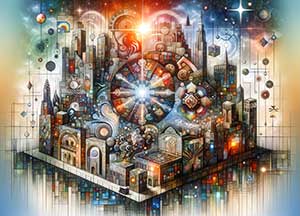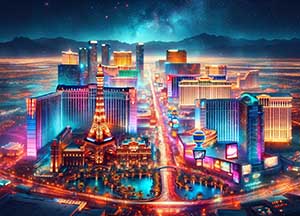The Influence of 3D Printing Technology on Exotic Car Manufacturing - Las Vegas Edition
2024.8.19
by: White Wolf
3D printing is revolutionizing many industries, changing the way we manufacture, consume, design and even how we live. It’s doing the same in exotic car manufacturing, an industry where new ways to design, produce and assemble parts improve performance, customisation and efficiency.
Customization and Design Freedom
Another of the great benefits of 3D printing is elaborate and highly customized designs being made more easily and economically. Where exotic cars are concerned, manufacturers can make parts which, though possible to make with traditional methods, would be prohibitively difficult and expensive to produce. This is important in the exotic car market: exotic cars are known for being customisable to a buyer’s wishes. Buyers can choose exactly what they want in terms of practical aspects like engine size, and cosmetic aspects like the exterior and interior styling of the vehicle.
With 3D printing, a manufacturer could churn out a one-off component which is adapted to your specific requirements – and it wouldn’t have to be quite so brown. A few years earlier, we’ll see much more freedom in design, as the extra capabilities enabled by 3D printing unleash a wave of creativity. Designers will be able to play with all the shapes which are possible but impossible with traditional manufacturing. One effect will be a move away from simple shapes. Intricate lattice structures – a network of not-quite-triangular holes, perfectly sealed at the junctions – can support a structure as well as a solid chunk of metal and weigh a lot less. This is already essential in high-performance cars; in the future, it will be a lot more common.
Rapid Prototyping and Development
3D printing speeds up the process of developing products, because it takes less time and costs less than building physical prototypes using more traditional manufacturing methods. Developing products can involve creating and testing many iterations of a part and, with 3D printing, this process has been drastically accelerated.
The speed at which this is possible is a great boon for exotic carmakers eager to develop new vehicle aesthetics and new performance envelopes. The iterative nature of combinatorial prototyping allows engineers to detect design flaws and make adjustments to the combinatorial matrix. Parts can be optimized for better performance, durability and performance/weight ratios. The iterative process speeds up the time-to-market for new models.
Cost Efficiency
While exotic cars typically have big price tags, manufacturers can always benefit from becoming more efficient and less expensive, as well. 3D printing provides these advantages through reduced material waste and reduced or non-existent tooling costs. In addition to reducing waste, many conventional manufacturing processes are subtractive – material is carved out of a larger block until its composition matches the target shape. This means a lot of the material starts out in the final product unneeded and unaccounted for in the final price. And more scrutiny-heavy materials, like titanium or even carbon fiber, will similarly increase the cost of waste.
By comparison, 3D printing is an additive process – layers of material are deposited to produce a part. You don’t have to waste money milling matter away from the rest of the block; you use only the material you need for the part. Meaning, you don’t have to buy more material than you need, which will also lower material costs. You can also make parts only when you need them, meaning you don’t have to keep massive inventories around.
Lightweight and High-Performance Parts
Weight reduction is crucial to the performance of expensive sports cars. For example, driving a lighter car means it can be faster and more responsive as well as more economical with fuel usage. 3D printing allows for the creation of lightweight parts without sacrificing strength or durability. Materials such as titanium or carbon fiber, which regularly feature in exotic cars, are appropriate for 3D printing to create components being both strong and light.
For instance, the luxury performance car manufacturer Bugatti has used 3D printing to make titanium brake calipers which are not only lighter than traditionally produced calipers, but also have better performance characteristics. By reducing the weight of the moving parts of the vehicle, it is easier to improve performance and handling.
Complex Geometries and Integration
The ability to manufacture parts with complex geometries which conventional techniques simply can’t match can be equally as important: manufacturers of exotic cars will often aim to integrate several functions into one component.
For example, a 3D-printed exhaust manifold with flow paths optimally arranged could be created as a single-piece component in contrast to a conventional manifold welded or otherwise assembled from several parts, which could lead to improved performance, lower weight and greater reliability. The ability to create more complex and integrated components, as a consequence of the additive nature of the process, could foster novel design concepts and offer various engineering advantages.
Supply Chain Flexibility
For exotic cars, the traditional supply chain can involve several suppliers, and the lead times for specialized parts can be long. 3D printing introduces greater flexibility because manufacturers are no longer limited to procuring parts from suppliers if they can print parts locally or near to where they are needed. This near-sourcing can shorten lead times, reduce transportation costs, and help to insulate companies against supply disruptions occurring further upstream in the chain.
Furthermore, 3D printing lets the manufacturer quickly address changes in supply or design requirements. If a part needs to be altered or replaced, a new, 3D‑printed part can be made and installed in a matter of days, rather than weeks or months. It takes a fast car to keep pace with the other supercars on the road, but it takes a faster one to stay ahead.
Environmental Considerations
While exotic cars are often accused of being environmentally unfriendly, 3D printing could help to make the manufacturing of these products more eco friendly; for example, the reduced material waste and the lightweight parts produced can reduce energy consumption and emissions, and recycled or eco-friendly materials could increasingly be used in the manufacturing process.
Challenges and Future Prospects
Despite these benefits, the use of 3D printing in exotic car manufacturing is facing some challenges. The technology is still in its early stages of development and there is currently a trade-off in some areas of priority. In some materials, the properties limit its use, while in others the production speed and the size of the parts being manufactured limit its use. However, an ongoing development of 3D printing technology is eliminating these problems, in order to make the process more popular in the industry.
In the future, as technological synergies develop, 3D printing could also be coupled with other emerging technologies such as those for artificial intelligence (AI) and advanced materials. The former could enhance the design-to-manufacture process and the latter expand the scope of 3D printing’s applications to high-performance materials. Coming together, these advances will likely further increase the sway of 3D printing over the exotic car manufacturing space, inevitably bringing about more futuristic and superior performing vehicles.
3D printing will make exotic cars even more special than they already are by allowing for more customisation, better efficiency and higher performance. Although this technology is not without its hurdles, the future only looks brighter for 3D printed exotic cars.
1stLasVegasGuide.com

We List Only the Best
1st Las Vegas Guide is not a list of every business. Our website highlights only the best businesses / places / events are featured within these pages. This makes Las Vegas even more magical for residents and visitors alike.

Advertise Your Company
You can be seen by a high quality audience when you place an advertisement on 1st Las Vegas Guide. Not all companies are accepted… Call 702-210-4201 to be have your company seen by affluent buyers. You will be amazed how with the low price.

1st City Guide Expansion
1stCityGuide.com is the parent company of 225+ city guides worldwide. We are expanding and looking for Licensee partners to work together and provide a quality income when sharing the secrets of great cities around the world with visitors and residents alike. Call 702-210-4201 to discuss pricing and city guide availabilities.

